|
What is the Cube?
The cube is a mathematical body formed by six equal squares.
Other names are cubus or hexahedron.
In the 1980's Rubik's cube was so popular that it was
simply called "the cube".
...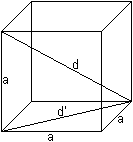 ... ...
|
There are 12 equal edges.
Three edges meet in a corner and stand perpendicularly
on each other in pairs.
The length of an edge is a. There are
There are 12 square diagonals of the length d' = sqr(2)a.
There are four space diagonals of the length d = sqr(3)a.
The volume is V=a³, the surface ist O = 6a².
The circumscribed sphere has the radius R = (1/2)sqr(3)a,
the inscribed sphere the radius r = (1/2)a.
The radius of the midsphere is rk = (1/2)sqrt(2)a. |
Views of a Cube top
Cubes in Perspective
... ... ... |
If students shall draw the picture of a cube in perspective
and you tell them before that all edges of the cube are equal some of them
draw the picture on the left.
You don't think that this is a good view of a cube. It
is more a column. Obviously the sloping lines must be shortened. |
There is the question, how much you
must shorten to get a nice view. If you have
the choice of the following four drawings most people would choose
picture 3 as the best.
 The sloping line is about half as large as the true length
of an egde. Thus you get the ratio k=1/2.
The sloping line is about half as large as the true length
of an egde. Thus you get the ratio k=1/2.
The ratio depends on the angles of the sloping lines.
The three following statements produce good pictures:

The mathematical base is the "sloping parallel projection",
where all ratios and angles are possible. You choose simple angles and
simple ratios (Book S).
There is Pohlke's theorem (also called "Main theorem of
the axonometry"):
Every real 2d-tripod OABC can be produced by parallel
projection of a Cartesian 3d-tripod O'A'B'C'.
(http://www.math-inf.uni-greifswald.de/mathematik+kunst/themen.html)
More Cubes in Perspective
.. .... .... |
Actually the drawing with equal edges on the left was
not used as a picture of a cube. Nevertheless you may take it. The advantage
is that the length in direction of the lines are real. The "isometric perspective"
(30° instead of 45°) is not so distorted and preferred. |
Central Projection
... ... ... |
Think of the edge model of a cube.
If you project it with light which comes from a point
you can get the picture on the left. |
Nets of a Cube
... ... ... |
Think of a paper cube and cut it along the edges. You
get nets of a cube. There are 11 nets. |
... ... ... |
Stereogram
You can see the cube three-dimensionally in the
following picture.
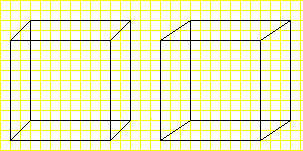 More on my web page Stereogram
More on my web page Stereogram
Shadow pictures
of a rotating cube
 |
For several years the "Deutsche Museum" in Munich has
the department "Das Mathematische Kabinett". A nice exhibit is a rotating
edge model of a cube. It is produced by parallel rays. You see the figures
on the left one after the other on a screen (square on the top, hexagon
with diagonal and a rectangle with a middle line).
You don't believe that these figures come from a cube
and must look twice. The cube is positioned in the way, that two edges
in opposite lie on top of each other. An axis (red) is interrupted in the
middle. |
Building a Cube top
Model with squares
...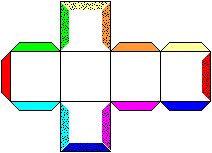 ... ...
|
This is the well known way to build a cube.
Draw a net and give the edges stripes for gluing.
Flex the stripes and glue them on the pointed fields with
the same colour. The cube will be closed with a lid on the right. |
Model
with edges
There are different methods of building cubes with rods.
>Remove the top of a match and connect the sticks
with two-component gluing.
>Take a toothpick or chopstick and connect them
with balls of modelling clay.
>Cut equal wire pieces with pincers and connect
them by soldering, so that they form a cube. It is clever to fix the three
pieces of a corner and let them touch before soldering. You can manage
if you use "die helfende Hand" (the helping hand) for two ends and
the real hand for the third end.
>Cut drinking straws in equal pieces and connect
them with tripods of florist's wire or paper clips.
More exact: There are building kits, which use 12 straws
and 8 tripods of plastic (One red tripod is removed below in the photo).
You can make tripods (below, dark green) yourself. You
bend them twice in six lines. There are bends in the tops, the two ends
of a wire meet in the middle.

... ... ... |
You can find a clever fashionable toy: Bar magnets
form the edges, steel balls the corners.
You pay 14€ for building kits of a cube (Springtime
2002).
In the meantime (Autumn 2003) there are different firms,
which produce them. Competition is good for the price. |
Symmetries of a
Cube top
The centre of the cube is a symmetry centre.
... ... ...
|
The cube has nine symmetry planes.
Three planes lie parallel to the side squares and go
through the centre (picture).
Six planes go through opposite edges and two body diagonals.
They divide the cube into prisms. |
You can find 13 rotation axes. If
you turn around one of these axes, the cube goes back to itself.
The following picture illustrates these facts. The numbers
under the cubes indicate the number of turns.

Interior Views
of a Cube top
All diagonals of the surface squares
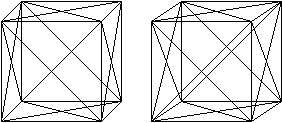
All spatial
diagonals
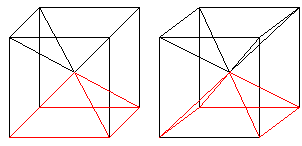
Cube with cut
corners

Cut the corners of a cube. Divide the edges in three
equal pieces to do this.
You get a body formed by 6 octogons and 8 equilateral
triangles.
Cuboctahedron
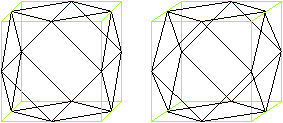
Cut the corners of a cube. Take half the edges.
You get a body formed by 6 squares and 8 equilateral
triangles. .
Tetrahedron
in the cube
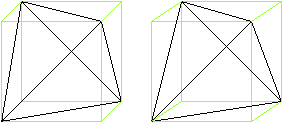
Draw some square diagonals and you get a tetrahedron.
Octahedron
in the cube
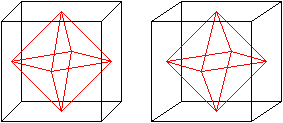
Join the centres of the squares by lines. You get an
octahedron.
More: If you join the centres of the triangles of a octahedron,
a cube develops again.
Cube and octahedron are dual to each other.
Three pyramids
of equal volumes
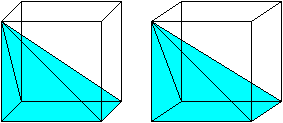
The largest
square inside a cube
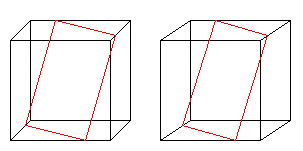
The red square is the largest square which fits a cube.
The corners of the square divide the edges in 1:3 (Book
G).
Cube in the
cube
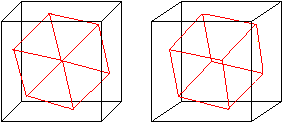
The red cube is the smallest cube which touches all sides
of the black cube (more on web page E).
Hexagon inside
a cube
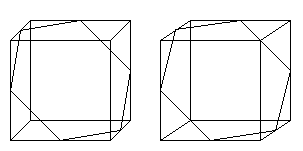
Join centres of some edges. You get an intersection through
the cube.
The intersection line is a hexagon of the edge length
sqrt(2)/2*a, if a is the edge of the cube.
A spatial equilateral
hexagon
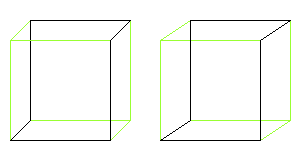
Delos Problem (problem
of cube duplication) top
The ancient Greeks could get rid of the plague after
an answer of the oracle of Delos, if they doubled the volume of its cube
altar. (This is one version of the legend.)
... ... ... |
The problem of the cube duplication goes to the equation
2a³=x³
and the solution x=a*2^(1/3). This was no solution to the
old Greeks, because the distance x had to be found from the length
only with circle and ruler . Now we know that this problem is unsolvable,
because only terms with square roots are possible to be constructed. Circles
and straight lines lead to linear and quadratic equations, which x³=a³
does not belong to. |
Two other problems also are unsolvable for the same reason:
The conversion of the circle into a square with the equal area ("squaring
the circle") and the division of any angle in three equal parts ("three-division
of an angle").
Polycubes top
You can form polycubes, if you add cubes touching in
one or several squares.

Die Zahlen geben die Anzahl der jeweiligen Würfelkörper
einer Sorte an. (Webseite K)
There are many puzzles based on polycubes.
Here is my "hit list":

I describe the puzzles on other places of my homepage.
There are 1
Soma cube, 2 Mac
Mahons Coloured Cubes, 3
Rubik's cube,
4
Happy Cube, and 5 Origami
cube.
More cube pages are tetracubes,
snake
cube, magic cube,
classic
puzzle cube, (and Dice).
Hypercube (4dimensional
cube) top
 You find a description on my web page hypercube.
You find a description on my web page hypercube.
Optical Illusions top
If you like, every representation
of a cube in the plane is a optical illusions. You think you see
a 3D cube, though the drawing plane is 2D.
Well known illusions with cubes
are "tilt figures". I restrict on them.
... ... ... |
The Necker cube (on the left) shows a cube in two perspectives
(on the right).
You switch over from one sight to the other. A square
is sometimes in front or in the back. You can only see one view at one
moment. |
... ... ... |

You have the questions:
Right or left? From below or above?
Three or five cubes? Five or three cubes? How many cubes?
The five pictures above are ambiguous. You see the cube
from below or above.


Do you look on a tower or into a hole?
The Cube as a
Building top
A building in the shape of a cube is not practical. Maybe
because of that architects and artists have taken the challenge and became
creative. The results are many original show-pieces and sculptures all
over the world.
Here is a small look back on the unforgettable Expo 2000
in Hanover, Germany.
 1 The T-Digit of the "Deutsche Telekom" was a centre
of the exhibition area. You could look at a large screen sitting on the
steps of show stairs where (even in the sunshine) an impressive light TV
picture was to be seen. Have a look at the French Open in Paris.
1 The T-Digit of the "Deutsche Telekom" was a centre
of the exhibition area. You could look at a large screen sitting on the
steps of show stairs where (even in the sunshine) an impressive light TV
picture was to be seen. Have a look at the French Open in Paris.
2 The exhibition cube of Mexico was seen from nearly
every point of the area.
3 The Iceland cube was unforgettable: It was dark
blue and over it there was a water layer. Inside there was a round water
pond whose surface was used as a screen for a movie about Iceland in the
bird's-eye view. In the end of the performance an artificial geyser erupted.
4 I forgot to take a photo of the Norwegian cube
building equipped with a waterfall :-(.
...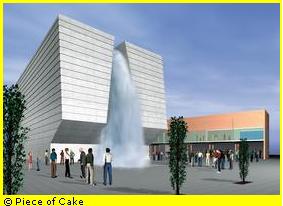 ... ... |
Therefore I restrict on a model, which you could find
on the internet before the Expo opening. (The waterfall didn't become so
mighty.)
You entered the "room of silence" after a slight shower.
You could sit on the hard floor for some minutes and watch the Norwegian
sceneries on all six squares. From time to time stones rolled down the
rocks (only acoustically). It was not allowed to talk. My wife... (censorship!) |
Hint
The origami cube is a cube that is folded from a square
sheet of paper.
You can find many cubes of this type on my origami
cube website.
...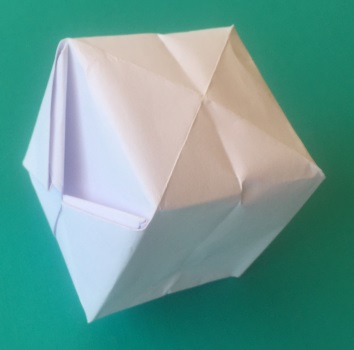 |
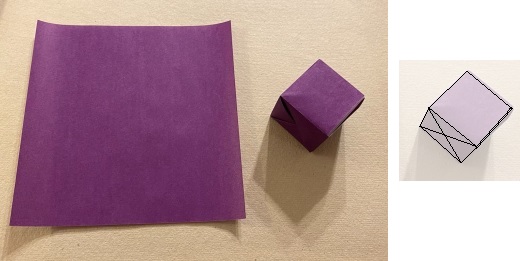 |
The
Cube on the Internet top
German
H. B. Meyer (Polyeder aus Flechtstreifen)
Hexaeder,
Würfel
(spezial)
Richard Mischak
Würfel
Wikipedia
Würfel
(Geometrie), Platonischer
Körper, Delisches
Problem, Expo
2000
English
David Eppstein (Geometry Junkyard)
Box
in a Box
Easy Origami (Youtube)
Origami:
Simple Modular Cube
Eric Weisstein (MathWorld)
Cube,
Prince
Rupert's Cube
H. B. Meyer (Polyeder aus Flechtstreifen)
Cube,
Cube
(special)
Wikipedia
Cube,
Platonic
solid,
Doubling
the cube,
Expo 2000
Youtube "Origami with Thao Bui"
Origami
Cube - "Magic" Cube (Shuzo Fujimoto)
Youtube "JeremyShaferOrigami"
Origami
Seamless Cube
Youtube "Fancy Origami Cube Tutorial
(Hyo Ahn)
Fancy
Origami Cube
References top
(G) Martin Gardner: Mathematischer Karneval, Ullstein
Berlin 1977 (Seite 61)
(S) Hans Simon, Kurt Stahl: Mathematik, Formeln und Gesetze,
Leipzig 1979 (Seite 471ff.)
(K) Michael Keller (früher: http://members.aol.com/wgreview/polyenum.html)
(E) David Eppstein (http://www.ics.uci.edu/~eppstein/junkyard/box-in-box.html)
Feedback: Email address on my main page
This
page is also available in German.
URL of
my Homepage:
https://www.mathematische-basteleien.de/
©
2002 Jürgen Köller
top |






















 ...
...
 ...
... ...
... ...
...
 ...
...
 ...
... ...
...
 ...
...
